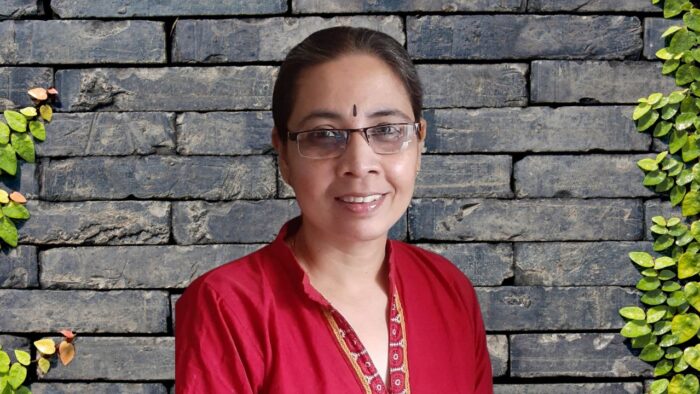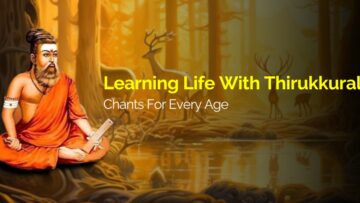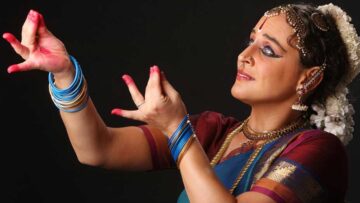Bharati Venkat’s story on Subadhra in the Aryaa, Anthology on Vedic Women, takes us deep into the Mahabharata and the consequences of war on families, especially mothers. The transformation of Subadhra, as the favourite daughter of her father (Adi-parva 221.17) as she is referred to by her brother Lord Krishna, to the Rajmatha of two kingdoms is captivatingly explained by Bharati in this interview.
One can listen to her talk about the Mahabharata for hours. Bharati demolishes the myths, focuses on the motivation of the characters, and most importantly makes us want to hold the Mahabharata closer to our hearts.
You are a master story teller. You have mentioned you inherit this from your father. How have you used this skill to spread a greater understanding of the Mahabharata to younger audiences over the last one year?
I strongly believe that we can weave moral values, ethics into our children using our itihasas. I speak from experience when I say that these stories help delineate right from wrong for little ones. Even before Aryaa or even Unsung Valour happened, I was trying out various initiatives to spread the story of this great epic, its messages, the concept of dharma within, via different social media channels in different formats.
For example, I have a series of byte sized posts giving out little known facts from the Mahabharatha, called my MB-on-whatsapp series on my instagram and twitter accounts @MyMbJourney. Then last year I did a story series called StoryinSquares where each tale is told in just four little boxes of text. I have a Substack account where I share MB insights, fictionalized short and long tales, interpretations of the epic’s major events and more. I have recently started a 10 minute podcast series called MBin10. I also hold sessions and workshops on various aspects of the Mahabharatha, for example, I did a series of 7- 8 sessions on Karna from his birth until death, addressing the many myths associated with him.
Nowhere more than in Jagganath Puri is Subhadra, your chosen character worshipped more dearly. Here many of the devotees take Her as the Parashakti, Sahalipta Shakti, Jogamaya, Kampilya Vasini, Ekanansa, Bhubaneswari, Mahalaxmi and many other forms of the Supreme power of the World. How would you connect this to her role in the Mahabharata?
True, Subhadra gets her due in Jagannath, in many ways. While as per the Vyasa Bharatha, Subhadra does not have a divine connotation, the women in the epic do not really need any to come across as powerful, righteous, courageous epitomes of feminine grace and resilience. Their actions, their courage in the face of traumatising events, their sheer grit and perseverance make them ideal role models for us all. When the feminine and masculine shaktis work in tandem, the world is on the path of progress. This is demonstrated over and over again by the itihasa and the various characters within. Perhaps by not giving Subhadra a clear divine association in the Mahabharatha, Vedavyasa was telling us that even as mere mortals, we can do much better than we are doing now, that not being divine should never become an excuse for not doing the right thing.
You speak of the Mahabharata as an itihasa in which there’s a striving for peace, even though people see it as an epic of the battle. As a sister, wife, mother and subsequently Raja Matha, how did Subhadra influence the ethical fibre of all those around her?
Just one exemplary character from the itihasa gives you the answer to this question. Abhimanyu – the young son of Arjuna who nearly ended the war single handed on Day 13. But in marveling at his prowess, we often overlook one significant aspect. Abhimanyu fought a DHARMA yuddha against adharmis who surrounded and attacked. Well versed with divyastras, he did not wield them against common soldiers to break out of the chakravyuha. The boy was equally aware of kshatriya dharma and did not surrender or retreat either, but chose to die fighting until his last breath. Abhimanyu encompassed the ideals of Subhadra herself because, remember, he was brought up by his mother since his father was on exile for 13 years of his life. Thirteen formative years at the end of which the war happened.
The single most awe inspiring aspect about Abhimanyu is that he understood dharma with all its nuance so beautifully at such a young age. He was not old enough to have a lot of exposure to the world at large so primarily the influential figure in his life was his mother and of course uncles. I feel, Abhimanyu’s conduct during the entirety of war, where he often led the Upapandavas from the front, took on the greatest (including Bhishma), the way he accepted the chakravuyha challenge despite knowing he could die and the way he fought until the end fearlessly and without breaking kshatriya code- all of these are indications of Subhadra’s influence. The way she holds strong after Abhimanyu’s death reflects how well she practices what she must have preached to him too.
Subhadra’s role or influence may not be mentioned in detail in the text but her impact on those around her is evident. It is Subhadra’s blood line that ascends to the throne, via Abhimanyu’s son. Subhadra mothers Draupadi’s sons too, she becomes a pillar of strength for young widowed Uttara and she is given her due when the Dharmaraja himself bids her goodbye and in a way, formally passes on the baton to her. Let us not forget the first meeting of Subhadra with Draupadi. Krishna’s beloved sister simply dresses herself as a cowherd maiden and approaches Draupadi with complete humility. She is now the wife of Aryavarta’s greatest warrior, the sister of Narayana himself and yet Subhadra is able to set all these ‘labels’ aside and approach Draupadi as herself, earning her affection instantly. A lot of the Mahabharatha’s biggest and most poignant messages lie in the subtext. We must delve a little deeper than the words to get at them.
As we know, most characters are not uni-dimensional, with shades of gray. How can we see that in Subhadra?
Subhadra comes into her own only post dyuta. Until then, we do not see her taking a central role or taking up responsibilities on par with, say, Draupadi. In fact, she is content to live in Draupadi’s shadow. Perhaps it would not be wrong to call her immature until then, simply taking pleasure in being the wife of Arjuna. That Krishna doted upon her is clear from the very way in which he describes her to Arjuna. She is a lot younger than her husband of course so she can be forgiven for holding a rather child like world view then. But when the need arises, the woman rises like a phoenix and becomes the very pillar of her broken family.
Subhadra is connected to two great kingdoms and would be the guardian of both their heirs. What qualities do you think administrators today can emulate from her?
First of all, to take on the guardianship of two such power centres requires immense courage and confidence. A clear sense of dharma, a clear purpose and responsibility towards praja, the ability to balance emotion with objectivity, the firm resolve to do what is right rather than what is convenient- these would just be some qualities that Subhadra would have brought to the table then. All of these can be extremely useful in any political situation today as well.
Your knowledge of the Mahabharata is extremely nuanced and detailed. If you had to change a few things in the life of Subhadra what would they be?
I think, the beauty of the characters from the itihasa lies in the very fact that they took life in stride and simply dealt with challenges without playing the victim card that we love so dearly today. Of course, I speak only for the heroes and heroines of the itihasa. Every event in her life contributed to who Subhadra became at the end. But if I had to change something, I would give her more time with her beloved husband. She got married, spent a very short time with Arjuna before the dyuta happened and Arjuna left. After war, nothing was the same at all.
In the book Aryaa itself, how does Subhadra stand out vis a vis the other women?
Tough question. If I may so, Subhadra is the proverbial ‘dark horse’. She breezes into the story as this young, naive, pampered princess with a large heart. But then life throws her a challenge she could never have imagined and she transforms into this pillar of strength. We see her stay back when her entire world has come to an end – her homeland no longer exists, her beloved brothers are gone, her husband is leaving and yet the woman stands strong. The contrast that we are given a glimpse of between the young Subhadra and the Rajamatha Subhadra may be one thing that differentiates her from the other great women in the book. I feel this is one way in which she stands out, she has not just lost a family or a husband or a home – she’s lost everything in one fell swoop.
Clearly each of the women in the Aryaa Anthology is a giant in Indian traditions. Were you able to capture all the aspects of Subhadra that you felt attracted to?
Absolutely not. With any character of the itihasas, I think we can never do justice properly, especially not with one story. There are just so many aspects to cover. In this story, I chose to focus on her life post the end of the Krishnavatara. There is so much more to Subhadra.
What are some common myths about Subhadra and how do you steer away from them and highlight the truth as an author?
Maybe not a myth but many people have a very strong impression of Subhadra as someone inconsequential to the whole itihasa. Nothing can be further from the truth. Again, it is Subhadra’s progeny that sits on the throne of Dharmarajya. It is Subhadra’s kin who rules Indraprastha. Subhadra is often written off as just someone Arjuna was infatuated with, someone who was too childish and irresponsible. The myth of how she fell asleep as Arjuna recounted the charkavyuha strategy is often given as example. Again, not true at all. As with all the myths about the Mahabharatha, I do my best to dismantle these through posts, stories, workshops, sessions, podcasts, insights on my various social media accounts and channels.
What are your plans to take this story further? How to move from plot and characters to civilizational values?
As of now, I have no plans to take the story of Subhadra further in this same format. But I feel that societal and civilizational values are deeply embedded in our ithasa stories and in every character. Simply by communicating the true stories of these stupendous people, we can build value systems, reinforce civilizational thought and give it a firm framework that cannot be rattled by outside influences, no matter how strong or persistent. When we talk about Subhadra as a role model for stree shakti, we are talking about strength and perseverence in the face of the greatest tragedy, we are talking about the firm commitment to place dharma above all else seflessly in circumstances that would break the best of us all. When we talk about Subhadra, we encapsulate all these values in a human character and convey it in a format that is easy to remember and comprehend.







